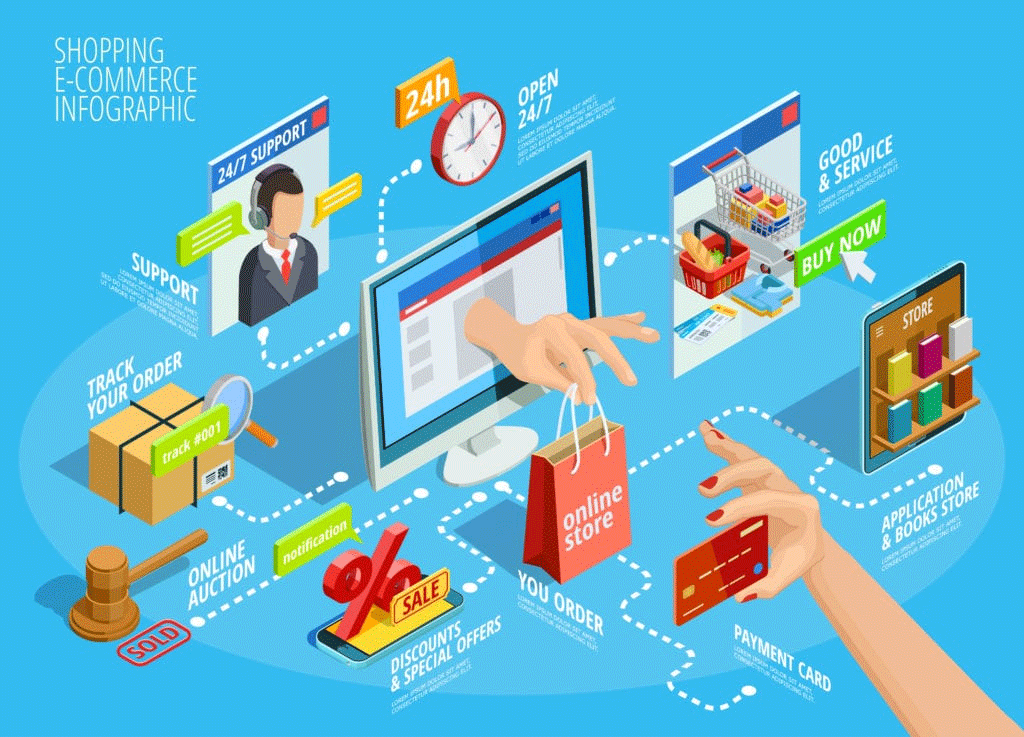Introduction to E-Commerce Websites
In today’s digital age, e-commerce websites have revolutionized the way businesses sell products and services online. These websites serve as virtual storefronts accessible to anyone with an internet connection, enabling transactions across borders and time zones. From large corporations to small entrepreneurs, e-commerce platforms have democratized retail, making it possible for businesses of all sizes to reach global audiences efficiently.
Definition and significance in digital commerce
An e-commerce website is an online platform where goods or services are bought and sold electronically. Unlike traditional brick-and-mortar stores, e-commerce sites operate 24/7, allowing customers to shop at their convenience. This accessibility eliminates geographical barriers and expands market reach, making it an indispensable tool for business growth in the digital economy.
Evolution of e-commerce platforms
E-commerce has evolved significantly since its inception in the 1990s. Initially limited to basic online catalogs and payment gateways, modern e-commerce platforms now incorporate advanced features like personalized recommendations, AI-powered product search, and seamless integration with mobile devices. The evolution continues with the rise of mobile commerce (m-commerce), social commerce, and the integration of emerging technologies like augmented reality (AR) and blockchain into shopping experiences.
Types of E-Commerce Websites
E-commerce websites cater to diverse business models and consumer preferences, each serving unique market segments and transactional needs.
B2C (Business-to-Consumer) platforms
B2C e-commerce websites sell products and services directly to individual consumers. These platforms focus on delivering a user-friendly shopping experience, with features such as product catalogs, customer reviews, and secure payment gateways. Examples include Amazon, Walmart, and Apple’s online store, which offer a wide range of products from electronics to apparel.
B2B (Business-to-Business) platforms
B2B e-commerce facilitates transactions between businesses, streamlining procurement processes and supply chain management. These platforms often feature bulk ordering, negotiated pricing, and account management tools tailored to the needs of corporate buyers. Alibaba.com and ThomasNet are prominent examples, connecting manufacturers, wholesalers, and distributors worldwide.
C2C (Consumer-to-Consumer) platforms
C2C e-commerce platforms enable individuals to buy and sell products or services directly with other consumers. These peer-to-peer marketplaces provide a platform for users to list items, negotiate prices, and complete transactions independently. eBay and Craigslist exemplify C2C e-commerce, fostering a dynamic marketplace for both new and second-hand goods.
Key Components of an E-Commerce Website
Successful e-commerce websites integrate multiple components to deliver seamless user experiences and operational efficiency.
Frontend design and user interface (UI)
The frontend of an e-commerce site encompasses its visual layout, navigation structure, and interactive elements. UI designers focus on creating intuitive interfaces that guide users through product categories, promotions, and checkout processes. Elements such as responsive design, clear call-to-action buttons, and visual hierarchy contribute to a positive user experience, enhancing engagement and conversion rates.
Backend development and server-side logic
Backend development involves the server-side operations that power an e-commerce website’s functionality. This includes handling product inventory, processing customer orders, and managing user accounts securely. Developers choose backend programming languages like PHP, Python (Django), or Ruby (Ruby on Rails) based on scalability needs and integration requirements with databases and third-party APIs.
Database management and integration
Database management is crucial for storing, organizing, and retrieving product data, customer information, and transaction records. E-commerce sites utilize relational databases (e.g., MySQL, PostgreSQL) or NoSQL databases (e.g., MongoDB, Redis) depending on data complexity and scalability demands. Efficient database design ensures fast query performance, data integrity, and seamless integration with backend systems.
Technological Stack in E-Commerce Development
The technological stack of an e-commerce website comprises frontend frameworks, backend technologies, and database systems optimized for performance and security.
Frontend technologies and frameworks
Frontend developers utilize HTML5, CSS3, and JavaScript frameworks such as React.js, Angular, or Vue.js to build responsive and interactive user interfaces. These frameworks facilitate component-based development, state management, and asynchronous data fetching, supporting features like real-time product updates and dynamic content delivery.
Backend programming languages and frameworks
Backend technologies like Node.js, PHP (Laravel), or Python (Django) handle server-side operations, business logic, and database interactions. Node.js excels in handling concurrent connections and real-time applications, while PHP frameworks offer rapid development and scalability for content management systems (CMS) and e-commerce platforms. Python frameworks provide clean code architecture and built-in security features, making them suitable for complex web applications.
Database systems and management tools
Database systems manage structured data storage and retrieval, supporting transaction processing, inventory management, and customer relationship management (CRM). Relational databases ensure data consistency and ACID compliance, while NoSQL databases offer flexibility in handling unstructured data and scaling horizontally for high-performance applications. Database management tools optimize query performance, data replication, and backup strategies, ensuring data reliability and system resilience.
E-Commerce Development Lifecycle
The e-commerce development lifecycle encompasses sequential stages from planning and design to deployment and maintenance, ensuring systematic project execution and continuous improvement.
Planning and requirement analysis
During the planning phase, stakeholders define project goals, target audience, and functional requirements for the e-commerce website. Requirement analysis involves gathering user stories, prioritizing features, and outlining technical specifications to align development efforts with business objectives and market expectations.
Design and prototyping
Designers create wireframes, mockups, and interactive prototypes to visualize the website’s layout, navigation flows, and user interactions. UI/UX design principles guide the creation of intuitive interfaces, accessible navigation menus, and persuasive call-to-action buttons that enhance usability and encourage conversion. Prototyping enables stakeholders to preview design concepts, validate user feedback, and iterate on design improvements before development begins.
Development and testing phases
The development phase involves coding, integrating frontend and backend components, and implementing core functionalities such as product catalog management, checkout processes, and payment gateway integration. Agile methodologies like Scrum or Kanban promote iterative development cycles, continuous integration (CI/CD), and collaboration between developers, QA engineers, and stakeholders. Testing encompasses unit testing, integration testing, and user acceptance testing (UAT) to identify bugs, validate functionality, and ensure compatibility across web browsers and devices.
User Experience (UX) Design in E-Commerce
User experience design focuses on optimizing usability, accessibility, and engagement throughout the customer journey on an e-commerce website.
Navigation design and usability principles
Effective navigation design simplifies browsing and product discovery, facilitating seamless transitions between categories, filters, and search results. UX designers prioritize intuitive navigation menus, breadcrumb trails, and persistent shopping carts that guide users through the purchase process and minimize friction points.
Mobile responsiveness and adaptive design
With mobile commerce (m-commerce) on the rise, UX designers prioritize responsive design techniques that ensure e-commerce websites adapt seamlessly to various screen sizes and device orientations. Mobile-first design principles prioritize mobile users’ needs, enhancing touch-friendly controls, fast-loading performance, and streamlined checkout experiences for smartphone and tablet users.
Conversion rate optimization (CRO) strategies
Conversion rate optimization (CRO) strategies aim to maximize the percentage of website visitors who complete desired actions, such as making a purchase or signing up for a newsletter. UX designers conduct A/B testing, heatmap analysis, and user behavior studies to identify conversion barriers, optimize product page layouts, and refine call-to-action (CTA) placements that encourage user engagement and increase sales.
Payment Gateway Integration
Payment gateway integration enables secure online transactions and facilitates seamless payment processing for customers purchasing products or services on e-commerce websites.
Types of payment gateways
E-commerce websites integrate various payment gateways, including PayPal, Stripe, and Authorize.Net, to accept credit card payments, digital wallets, and alternative payment methods like cryptocurrencies. Payment gateways encrypt sensitive payment information, authenticate transactions, and facilitate fund transfers between customers, merchants, and financial institutions securely.
Security considerations and PCI compliance
Security measures in payment gateway integration prioritize data encryption, tokenization, and compliance with Payment Card Industry Data Security Standard (PCI-DSS) regulations. E-commerce websites implement HTTPS protocols, SSL/TLS encryption, and two-factor authentication (2FA) to protect customer information, prevent fraud, and ensure PCI compliance for secure payment processing and transaction security.
User-friendly checkout process
A streamlined checkout process enhances user experience and reduces cart abandonment rates by minimizing steps, eliminating distractions, and offering guest checkout options. UX designers optimize checkout forms with autofill capabilities, shipping address verification, and order summary displays that provide transparency, build trust, and encourage customers to complete purchases efficiently.
Product Catalog Management
Product catalog management involves organizing, categorizing, and presenting product listings effectively to enhance discoverability, facilitate browsing, and promote sales on e-commerce websites.
Structuring product categories and attributes
E-commerce platforms categorize products into hierarchical categories and subcategories based on product type, brand, or price range. UX designers implement faceted navigation, filter options, and sorting features that enable customers to refine search results, compare products, and find relevant items quickly.
Inventory management and stock tracking
Inventory management systems track product availability, stock levels, and replenishment processes to prevent overselling and out-of-stock incidents. E-commerce websites integrate inventory management software, barcode scanners, and real-time updates that synchronize product data across platforms, warehouses, and sales channels for accurate inventory control and order fulfillment.
Product search and filtering options
Effective product search functionality improves user experience by enabling customers to find specific items using keywords, attributes, or advanced search filters. UX designers implement search algorithms, autocomplete suggestions, and predictive search features that enhance search relevance, reduce bounce rates, and guide customers towards desired products with minimal effort.
Order Management System
An order management system (OMS) automates order processing, fulfillment workflows, and customer service operations to optimize efficiency, streamline logistics, and deliver seamless shopping experiences





